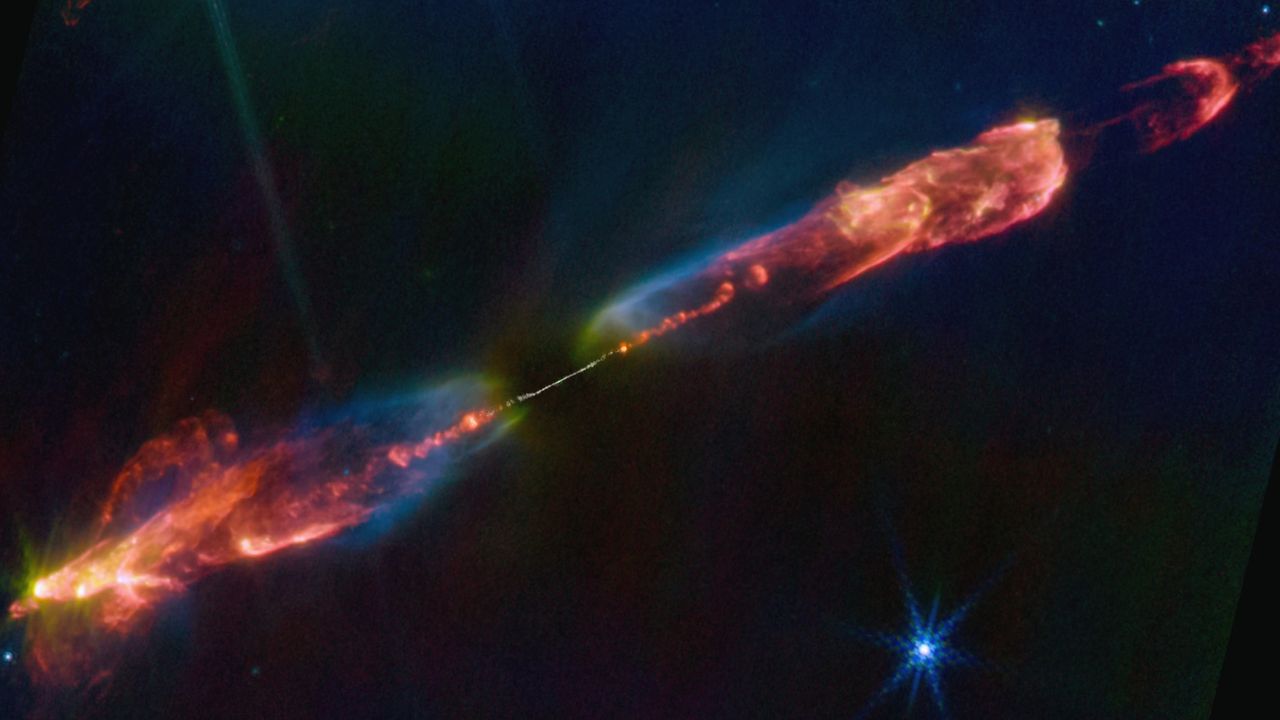Science
ALMA and JWST Uncover Secrets of Star Formation in HH 211

A recent study has provided significant insights into the process of star formation, focusing on a protostar known as HH 211, located 1,000 light-years away in the constellation Perseus. This research, published on August 13, 2023, in the journal Scientific Reports, utilized the advanced capabilities of the Atacama Large Millimeter/submillimeter Array (ALMA) in Chile and the James Webb Space Telescope (JWST) to explore this celestial object, revealing new details about how stars are born.
The formation of stars occurs within dense clouds of cold gas and dust. When these clouds achieve a certain mass, they collapse under their own gravity, leading to the birth of a protostar. As these young stars develop, they pull in surrounding material, forming an accretion disk—a swirling mass of gas and dust. This accretion disk plays a vital role in the star’s growth, but if it spins too rapidly, the material cannot easily fall into the star. Astronomers theorize that the energetic jets produced by protostars can help facilitate the movement of material from the disk into the star.
One of the key challenges in studying these protostellar jets is their proximity to the star, which makes them difficult to observe, even with powerful telescopes. Researchers have previously suggested that magnetic fields within the protostellar system could assist in launching these jets. The recent observations of HH 211 have provided a clearer understanding of this phenomenon.
The study indicated that HH 211, classified as a Herbig-Haro object, is approximately 35,000 years old and contains a central protostar with a mass of only 0.06 times that of the sun. The protostar is characterized by a striking bipolar jet—two beams of energized ionized material that emanate in opposite directions. Notably, the jets were found to be moving at speeds of around 66 miles per second (107 kilometers per second) while exhibiting a relatively slow rotation.
Researchers calculated that the jets originate from a region just 0.02 astronomical units, or nearly 1.85 million miles (3 million kilometers) from the star. This proximity provided a unique opportunity to validate models suggesting that magnetic fields can act as a slingshot, effectively launching gas outward.
The stunning images captured by the JWST in near-infrared wavelengths reveal a colorful display of the bipolar jet; however, the thick dust surrounding the central region obscures the jet’s origin. The ALMA observations have filled this gap, presenting a clear view of the inner part of the accretion disk in submillimeter wavelengths. By combining the data from both telescopes, researchers have produced a comprehensive image that illustrates the birth of a star.
For the first time, the launch point of a protostellar jet has been captured, confirming its essential role in the growth of new stars. The jets not only facilitate the transfer of material but also help to remove excess angular momentum from the accretion disk, allowing material to flow more freely toward the star.
This groundbreaking research enhances our understanding of the complexities of star formation and sheds light on the intricate processes that govern the birth of stars in our universe. As technology continues to improve, astronomers remain hopeful that further studies will uncover even more secrets hidden in the cosmos.
-

 Science2 weeks ago
Science2 weeks agoIROS 2025 to Showcase Cutting-Edge Robotics Innovations in China
-

 Politics2 weeks ago
Politics2 weeks agoJudge Considers Dismissal of Chelsea Housing Case Citing AI Flaws
-

 World2 weeks ago
World2 weeks agoBravo Company Veterans Honored with Bronze Medals After 56 Years
-

 Lifestyle2 weeks ago
Lifestyle2 weeks agoStone Island’s Logo Worn by Extremists Sparks Brand Dilemma
-

 Top Stories2 weeks ago
Top Stories2 weeks agoIndonesia Suspends 27,000 Bank Accounts in Online Gambling Crackdown
-

 Sports2 weeks ago
Sports2 weeks agoMel Kiper Jr. Reveals Top 25 Prospects for 2026 NFL Draft
-

 Health2 weeks ago
Health2 weeks agoStartup Liberate Bio Secures $31 Million for Next-Gen Therapies
-

 Health2 weeks ago
Health2 weeks agoTop Hyaluronic Acid Serums for Radiant Skin in 2025
-

 World2 weeks ago
World2 weeks agoHoneywell Predicts Record Demand for Business Jets Over Next Decade
-

 Politics2 weeks ago
Politics2 weeks agoNew Jersey Voters Urged to Register Ahead of November Election
-

 Lifestyle2 weeks ago
Lifestyle2 weeks agoMary Morgan Jackson Crowned Little Miss National Peanut Festival 2025
-

 Sports2 weeks ago
Sports2 weeks agoYamamoto’s Mastery Leads Dodgers to 5-1 Victory in NLCS Game 2









